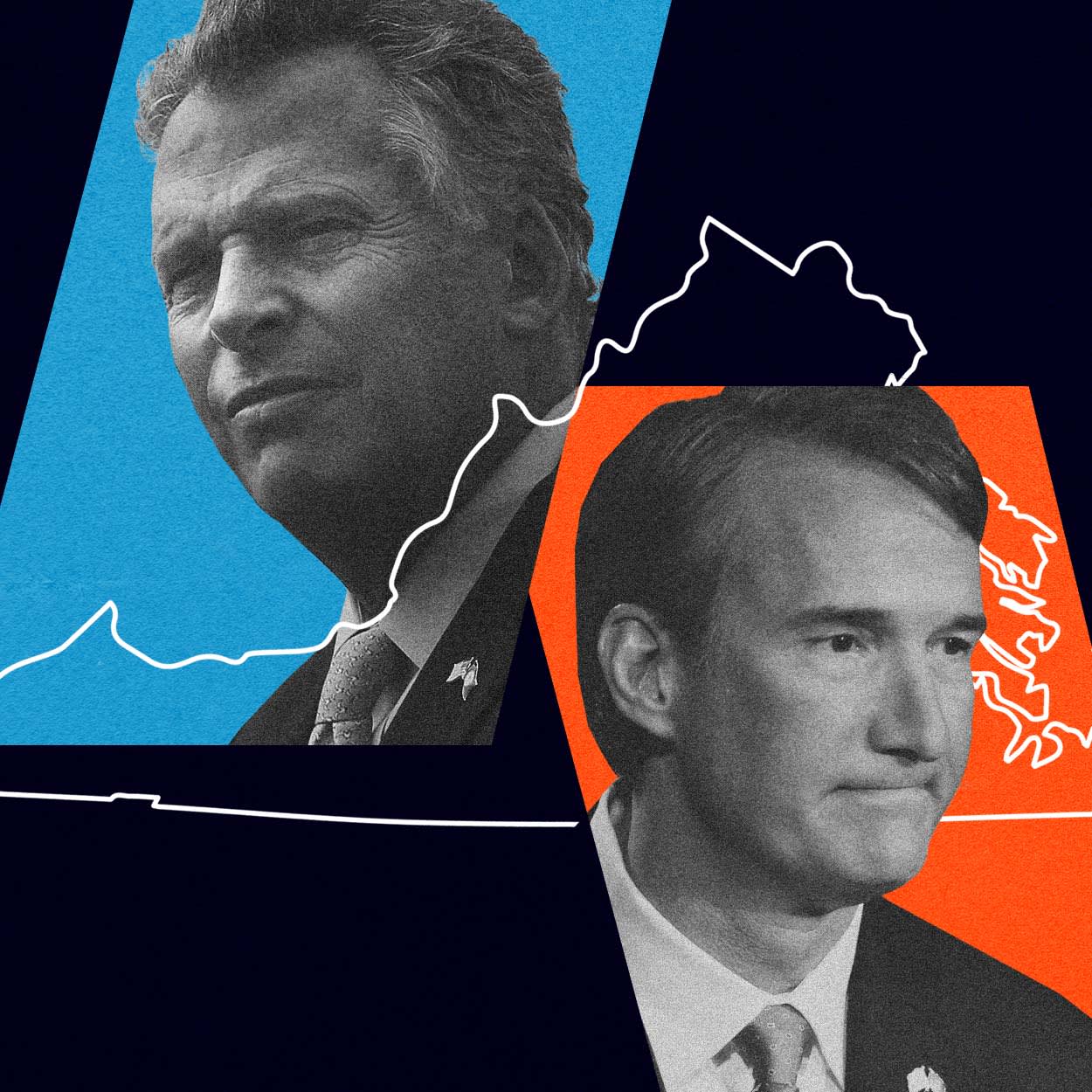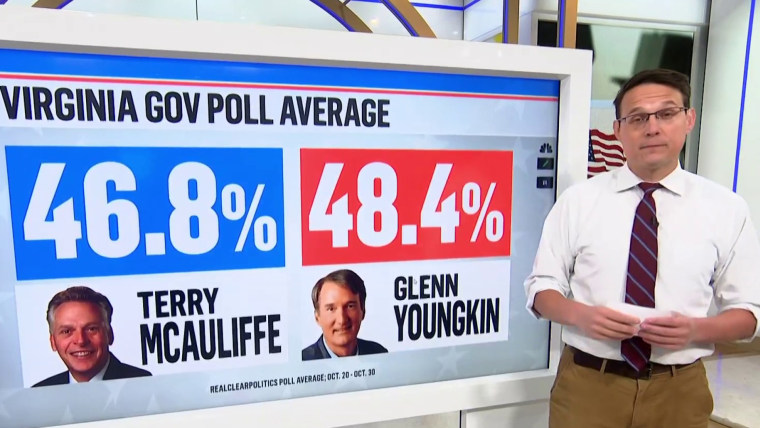WASHINGTON — All eyes are on Virginia, where voters have their say Tuesday in the first major election of President Joe Biden’s term — one both parties are watching closely for lessons ahead of next year’s midterm elections.
Polls show a neck-and-neck race between Democrat Terry McAuliffe, a former governor looking to reclaim the office, and political newcomer Glenn Youngkin, who is trying to crack the code on how to win as a Republican in a state former President Donald Trump lost by a wide margin.
The Covid-19 pandemic dominated the campaign’s early months, but as cases receded, other issues like abortion and education took center stage. Youngkin harnessed parental frustration with school closures and mask mandates as well as fears of anti-white bias in curriculum that dovetail with a national conservative backlash to critical race theory, a once-obscure academic field mainly only taught at the graduate level.
McAuliffe has tried to tie Youngkin to Trump, hoping to show the former president can still be an effective boogeyman to motivate the Democratic base and overcome lackluster enthusiasm for Biden and his gridlocked agenda in Washington.
Virginia, which elects its governors a year after the presidential election, has often served as an indicator of which way the political winds are blowing and which party is more engaged. Here are five things to watch:
1. Is Virginia a purple state again?
Former President Barack Obama won the commonwealth twice. Biden carried it by 10 percentage points last year. And no Republican has won statewide since 2009. When Democrats claimed total control of the Legislature in 2019, outgoing Gov. Ralph Northam, who is prohibited by the state Constitution from seeking a second term, declared Virginia “officially blue.”
But a win Tuesday by Youngkin or anyone else on the GOP ticket — or even a close loss — would reset the electoral calculus. If Democrats are struggling here, what does that mean for other Southern states like Georgia and North Carolina, where the party has made gains by copying the Virginia playbook and where Democrats hope to defend or pick up Senate seats in 2022?
Virginia was barely contested in the last presidential election, but a Youngkin victory might put it back in play, squeezing Democrats by making them play defense with working-class white voters in both the upper Midwest and in more diverse Sun Belt states where the party had been making gains lately.
2. Will the Democratic base turn out?
Black voters remain key to the Democratic coalition. McAuliffe in the closing weeks signaled concern about the constituency, accusing Youngkin of wanting to ban books by Black authors. The facts were more nuanced, with Youngkin framing his “Parents Matter” message around McAuliffe’s past vetoes of legislation that would have allowed parents to opt their children out of reading books with sexually explicit content. The book at the center of that debate? Toni Morrison’s Pulitzer Prize-winning novel “Beloved,” which recounts the horrors of slavery.
Youngkin’s campaign, meanwhile, emphasized a recent occasion when former Virginia Gov. Douglas Wilder — a Democrat who was the nation’s first elected Black governor — criticized McAuliffe in a local TV interview.
Turnout has traditionally been a challenge for Democrats in nonpresidential election, especially among people of color and young voters, and keeping them motivated will be critical next year.
Democrats are watching places like the Hampton Roads area and keeping in mind benchmarks from recent elections, when Northam earned 1.4 million votes in 2017, Sen. Tim Kaine received 1.9 million in his 2018 midterm re-election and Biden earned 2.4 million in 2020.
3. How much credit — or blame — does Trump get?
Youngkin accepted Trump’s endorsement and in the abstract hewed closely to Trump — and most of the GOP at large — on policy and culture issues. But he refused to campaign alongside Trump and at times had to distance himself from Trump’s most strident allies. Democrats tried to cajole Trump into campaigning for Youngkin, eager for a photo opp that could rally their party, as well as independent, Trump-weary voters, to McAuliffe in the closing days.
Trump seemed to be itching to be more involved, teasing last week that he’d be in Virginia soon. It turned out to be just that — a tease, and Trump’s presence in the home stretch was confined to a Monday “tele-rally.” But it’s been hard to gauge how much of a factor he is for voters on either side.
Republicans have their own turnout questions, too, without Trump on the ballot. The GOP will be watching Virginia’s vast rural stretches in the West and Southern reaches of the commonwealth, where they need high turnout to overcome Democratic advantages in more populated areas.
4. What does the Virginia House say about the U.S. House?
While the headlines will be all about the governor’s races in Virginia and New Jersey, operatives in next year’s congressional races will be closely watching the 100-member Virginia House of delegates, all of whom are up for re-election Tuesday.
Democrats won full control of the Virginia Legislature for the first time in decades in 2019, continuing their winning streak under Trump. But if Democrats lost the Virginia House or see their current 55-45 margin shrink significantly, it would not only imperil Democrats in Virginia but likely foreshadow trouble for the party nationwide in 2022.
State legislative elections can serve as more pure expressions of voters’ feeling about each party since individual candidates are generally less well known. And with 100 different races and districts to analyze, they can offer a more nuanced view of different electorates than statewide contests.
5. Do the suburbs stay blue or bounce back?
With Trump out of office, one of the biggest questions in politics across the country is whether Democrats can retain their support in historically Republican suburbs that shifted blue under Trump, or if the culturally liberal but fiscally moderate suburbanites will return to GOP.
The first big signs of the Democratic momentum under Trump was an unexpected surge in support for Northam in Virginia’s suburbs in 2017. And suburbs have largely dictated many of the key elections since, from the blue wave in the last midterms in 2018 to Biden’s victory in 2020 in both the Democratic primary and the general election.
Observers will be closely watching places like Loudoun County, which has long been a bellwether and has been a flashpoint in the debate over education and critical race theory.
Source: | This article originally belongs to Nbcnews.com










